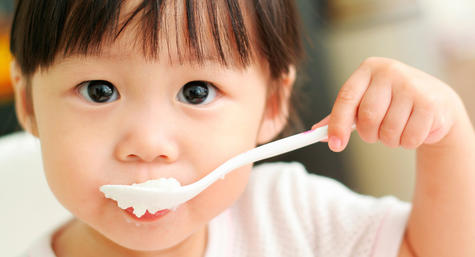One of the most stressful times to be a parent is early toddlerhood, when your baby, who has been subsisting mainly on breastmilk or formula, must suddenly make the switch to table foods. It’s hard to know how much she should eat, what to feed her, and it becomes doubly frustrating when your little one decides to shun many of the items you put in front of her!
The American Academy of Pediatrics (AAP) recently released new toddler feeding guidelines which will make it easier for parents to understand what to feed their kids, and how much. The AAP first alleviates he fears of parents who worry that their child is not eating enough. As they explain, in the first year of life, babies develop at an incredibly rapid pace. Once they reach a year of age, they begin to develop less quickly, and their need for food decreases. Between the ages of 1 and 3, the AAP says that kids need 40 calories per inch of height. Most kids will end up needing between 1000 and 1500 calories per day, which is not too hard to achieve between three meals and two snacks every day! So, if your little one turns up his nose at lunchtime, don’t fret. A dip in his calorie intake here and there is not a huge concern for a healthy child.
If you’re planning your kid’s meals from week to week, you’re likely wondering what to add to each meal and snack to create a balanced diet. The AAP suggests that grains should comprise the majority of your child’s diet, with 6 servings, or 250 calories. Toast and pasta, as well as rice and crackers, are favorites for many kids, which makes this goal realistic. The AAP recommends 2 to 3 servings each of both fruits and vegetables, or 75 calories of each. Fruit may not be such a hard sell, but veggies can be a challenge. Offer your toddler a variety of veggies, and you may just learn that she prefers cauliflower and carrots to corn and broccoli. The AAP also recommends 2 to 3 servings of dairy per day, such as yogurt and cheese, a couple of toddler favorites. As far as protein, the AAP suggests 2 servings, or 200 calories per day of protein such as chicken, fish, or eggs. And add 2 servings, or 200 calories per day, of legumes. If your child is not so thrilled about peas, lentils, or beans, try a pureed soup. And if your child does not have a peanut allergy, the AAP says to add a tablespoon of peanut butter to their diet, perhaps to crackers at snacktime.
These guidelines are just that: guidelines. If your child goes on a veggie strike or can’t stand yogurt or cheese, he’s likely getting enough calories and enough nutrients from other categories of food. Talk to your pediatrician if he completely abandons one of these categories, or seems to be eating less than his suggested calories per day, but many toddlers are picky from time to time and deviations from the guidelines here and there shouldn’t cause too much concern.

